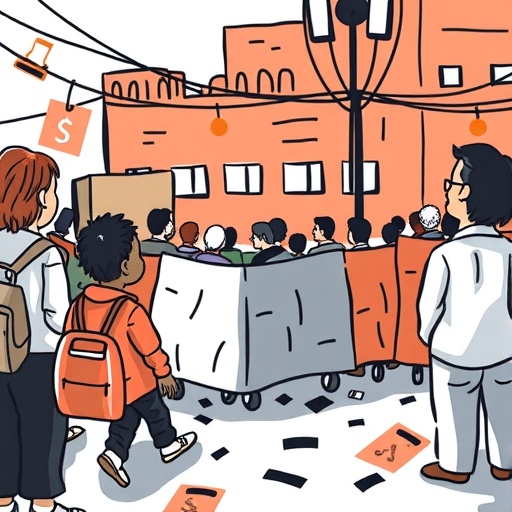In recent years, overcrowding in healthcare facilities has emerged as a significant challenge, particularly in urban Indian settings. This issue not only strains the healthcare infrastructure but also adversely affects the quality of patient care. A new study by Fatma et al. aims to tackle this pressing concern by analyzing the perceptions of stakeholders regarding existing and potential new patient referral mechanisms. The study highlights the urgent need for innovative solutions to streamline patient management and enhance healthcare delivery.
Urban Indian healthcare facilities are facing unprecedented pressure due to rising populations and increasing demand for medical services. This has led to overcrowding in hospitals, resulting in longer waiting times for patients, reduced access to essential services, and overall dissatisfaction among both patients and healthcare providers. The study underscores that addressing these challenges requires a multi-faceted approach involving various stakeholders, including healthcare professionals, policy makers, and patients themselves.
One of the core components of the study involves assessing current patient referral mechanisms that govern healthcare interactions in urban India. These mechanisms are critical in handling patient flow and ensuring that individuals receive timely care. However, many existing referral pathways are inefficient and poorly understood by both patients and providers. This lack of clarity often leads to confusion and delays in treatment, ultimately exacerbating the overcrowding problem.
The researchers conducted a thorough stakeholder perception analysis, gathering insights from healthcare practitioners, administrative staff, and patients. This qualitative approach allowed the team to examine not only the effectiveness of current referral mechanisms but also the potential barriers to implementing new strategies. The findings reveal a consensus among stakeholders on the necessity for better communication and coordination within the healthcare system.
One of the noteworthy aspects of the study is its emphasis on the role of technology in facilitating patient referral processes. Digital solutions can significantly improve the efficiency of referrals by providing real-time information about available healthcare resources and patient needs. Implementing user-friendly apps or platforms that guide patients through the referral process could work to alleviate some of the congestion in overcrowded hospitals.
Moreover, the authors propose investing in training programs for healthcare personnel to enhance their understanding of the referral system. By equipping providers with the necessary knowledge and skills, they can better educate patients on available options and the importance of utilizing referral pathways effectively. This not only fosters a sense of ownership among healthcare workers but also empowers patients to take charge of their health.
The study also highlights the importance of community engagement in addressing overcrowding. Local communities play a crucial role in healthcare delivery, and their involvement can lead to more tailored solutions that reflect the unique needs of each area. By collaborating with community organizations, healthcare facilities can promote awareness of available services and encourage the utilization of outpatient care, thereby reducing the burden on hospitals.
An essential finding of the study is the perception gap between patients and providers regarding the referral process. While healthcare professionals may view existing mechanisms as adequate, many patients experience confusion and frustration when navigating the system. Bridging this gap is crucial, as it will enable the healthcare sector to implement practical solutions that resonate with both providers and users.
Additionally, the research points to the need for policy reforms that focus on integrated healthcare delivery systems. As urban areas continue to grow, a coordinated approach that encompasses primary, secondary, and tertiary care will be vital in managing patient flow and outcomes. Adopting policies that promote collaboration between different levels of healthcare can lead to more seamless transitions for patients and better utilization of resources.
The authors also discuss the implications of social determinants of health on overcrowding. Factors such as socioeconomic status, education, and access to information can significantly influence how patients engage with the healthcare system. Addressing these determinants is key to reducing disparities in healthcare access and ensuring that all patients benefit from referral mechanisms.
In addition, the study acknowledges the potential impact of public health campaigns that educate communities on preventive healthcare practices. By promoting wellness and early intervention, these campaigns can reduce the likelihood of patients requiring hospitalization, thus contributing to less crowded facilities. Health education should aim to empower individuals to make informed decisions about their health and seek care in a timely manner.
Furthermore, the study emphasizes the importance of continuous evaluation and feedback in refining referral systems. By implementing mechanisms for ongoing assessment, healthcare facilities can identify areas of improvement and adapt their referral processes to better meet the needs of their communities. Such an iterative approach will ultimately enhance overall patient care and satisfaction.
In conclusion, Fatma et al.’s research provides a comprehensive examination of the challenges associated with overcrowding in urban Indian healthcare facilities. By engaging stakeholders in the analysis of patient referral mechanisms, the study lays the foundation for actionable strategies aimed at improving the efficiency of healthcare delivery. The insights gained highlight the intersections of technology, community engagement, and policy development in fostering an effective healthcare system suited to the demands of a growing urban population.
Overall, this study serves as a call to action for healthcare leaders and policymakers to prioritize innovative solutions that can address overcrowding effectively, ensuring that every individual has access to the care they need. As urban India continues to navigate the complexities of healthcare delivery, it is imperative that stakeholders come together to create a system that is not only responsive but also sustainable in the long run.
Subject of Research: Patient referral mechanisms and overcrowding in urban Indian healthcare facilities
Article Title: Towards mitigating overcrowding in urban Indian healthcare facilities: stakeholder perception analysis for existing and potential new patient referral mechanisms.
Article References: Fatma, N., Kala, K. & Ramamohan, V. Towards mitigating overcrowding in urban Indian healthcare facilities: stakeholder perception analysis for existing and potential new patient referral mechanisms.
BMC Health Serv Res 25, 1428 (2025). https://doi.org/10.1186/s12913-025-13602-y
Image Credits: AI Generated
DOI: 10.1186/s12913-025-13602-y
Keywords: overcrowding, healthcare facilities, patient referral mechanisms, urban India, stakeholder perception, healthcare delivery




